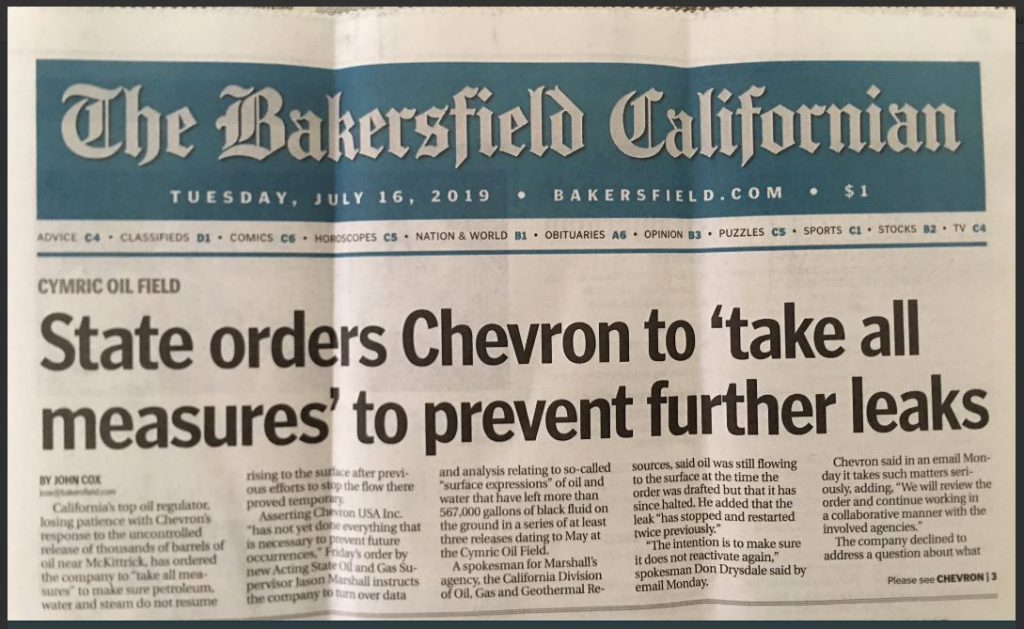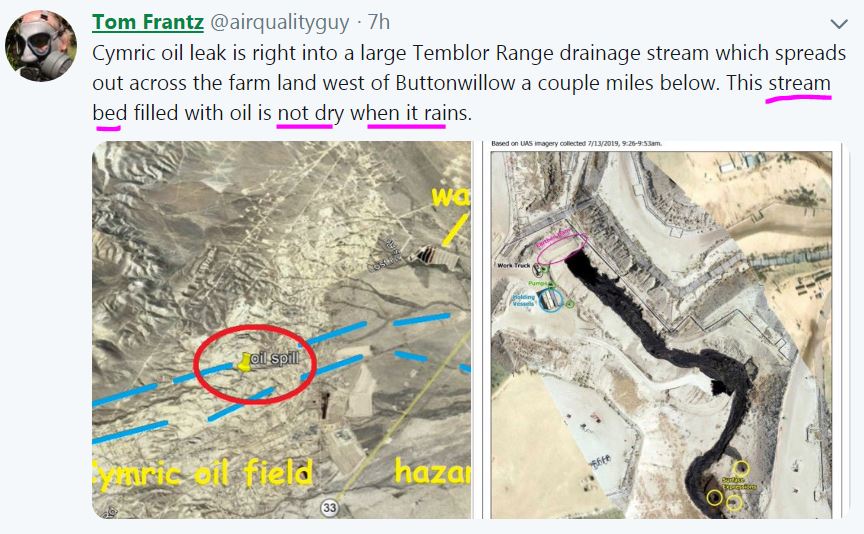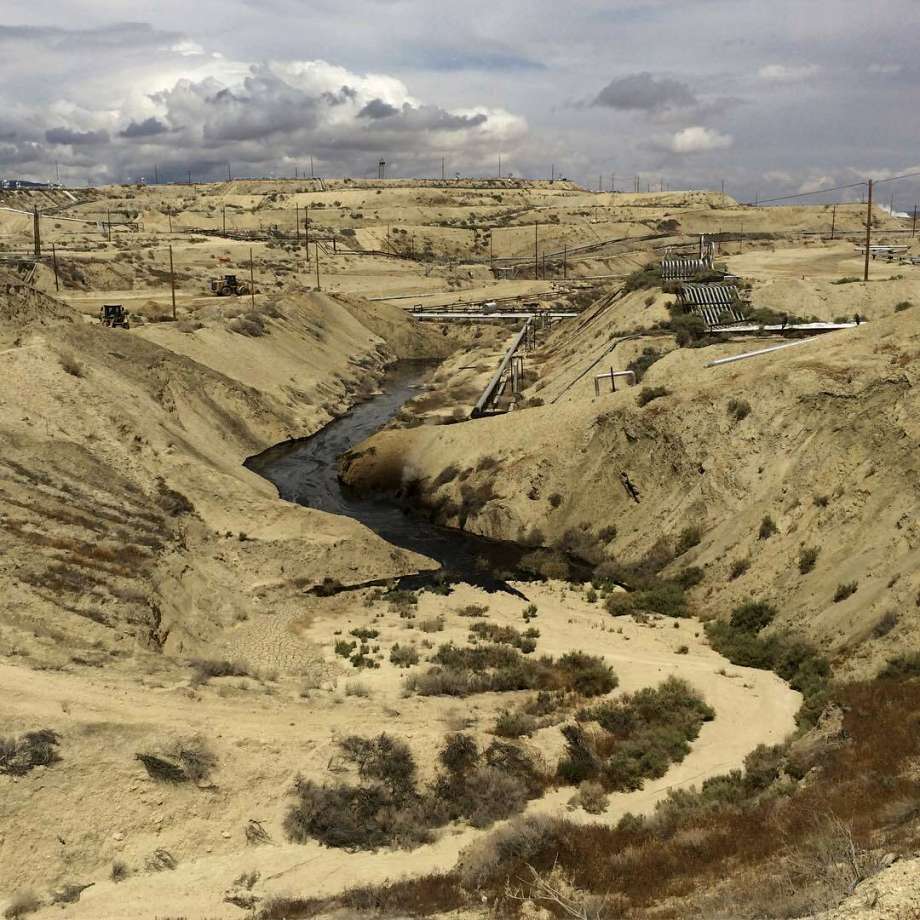California Announces New Oil and Gas Initiatives, Actions reflect expanded mission and vision for regulators Press Release by The Department of Conservation’s Division of Oil, Gas and Geothermal Resources, Nov 19, 2019
- A halt of approvals of new oil extraction wells that use high-pressure steam to break oil formations below the ground, a process linked to recent oil leaks in Kern County
This moratorium prohibits new extraction wells that use a high-pressure cyclic steaming process to break apart a geological formation to extract oil. During the moratorium, regulators will consult with experts to examine records from recent leaks of oil and water, known as surface expressions, in the Cymric oil field in Kern County to determine whether high-pressure cyclic steaming can be done safely and in compliance with recent regulations that make surface expressions illegal. Oil and gas regulators could require certain safety practices, update regulations to impose new rules, or prohibit the practice altogether.
2. Rules for public health and safety protections near oil and gas extraction facilities will be updated and strengthened
3. Pending applications to conduct hydraulic fracturing and other well stimulation practices will be independently reviewed
In recent months, the Governor also has:
- Made the state’s first major workforce investment of $165 million over five years to help enable economic transition away from dependence on fossil fuels.
- Changed leadership overseeing oil and gas policy at CalGEM and the Department of Conservation.
- Signed five bills to improve regulatory oversight of oil and gas extraction in the state.
- Strongly opposed President Trump’s effort to expand oil and gas extraction on federal lands within California.
- Initiated the most comprehensive air monitoring campaign in the country in communities located near oil and gas operations.
- Protected the state’s clean car standards against efforts by the Trump Administration to roll back greenhouse gas emission standards that protect public health and combat climate change.
- Supported a series of regulations and incentives directed at supporting zero emission transportation alternatives to facilitate the transition from petroleum.
Contact:
Public Affairs Office
email hidden; JavaScript is required
(916) 323-1886
Gov. Newsom blocks new fracking, pending scientific review by Madeleine Brand, Nov. 20, 2019, KCRW
Governor Gavin Newsom announced another investigation this week that could set back the oil industry. He said he won’t approve any new hydraulic fracturing permits, or fracking, until scientists can review the projects.
… Earlier this week, Newsom also called for expediting the closure of the Aliso Canyon natural gas storage facility.
California Halts Hundreds of Fracking Permits in Oil Producer Crackdown by Adam Beam, Nov 19, 2019, Time.com
California Gov. Gavin Newsom cracked down on oil producers Tuesday, halting approval of hundreds of fracking permits until independent scientists can review them and temporarily banning another drilling method that regulators believe is linked to one of the largest spills in state history.
The state Division of Oil, Gas and Geothermal Resources announced it will not approve new wells that use high-pressure steam to extract oil from underground. It’s the type of process Chevron uses at an oil field in the Central Valley that leaked more than 1.3 million gallons (4.9 million liters) of oil and water this summer.
That process is different from fracking, which uses water and other chemicals at high pressure to extract oil. California has 263 pending fracking permits but has not approved any of them since July. That’s when Newsom fired California’s top oil and gas regulator after learning the state had increased fracking permits by 35% since he took office in January, angering environmental groups.
… California has been a leader on environmental issues, with Newsom’s Democratic predecessor, Jerry Brown, making climate change his signature effort. Brown was criticized for failing to ban fracking or oil drilling, arguing that the state needed to tackle demand before moving on to supply.
The oil industry called Newsom’s changes “disappointing,” with the Western States Petroleum Association saying California’s environmental regulations already lead the world. [Pfffffft, that’s what all lying propagandizing oil and gas lobby groups “say” notably when things go wrong, eg Aliso Canyon mess; Chevron’s nasty seeps/leaks/spills; companies injected their toxic frac waste into protected aquifers]
“Every barrel delayed or not produced in this state will only increase imports from more costly foreign sources that do not share our environmental safety standards,” group president Catherine Reheis-Boyd. [Pfffft, the lying oil and gas lobby groups “say” that same damn thing across Canada too]
California is one of the top five states for oil production, producing more than 161 million barrels last year. Fracking occurs in some of the state’s largest oil fields, mostly in the Central Valley.
The steam method is less prevalent but accounted for 8 million barrels of the state’s oil production in 2018, according to the Department of Conservation. But regulators believe it is linked to the oil spill at a Chevron well that began in May.
It was the largest oil spill in California since 1990, when a tanker unleashed more than 400,000 gallons (1.5 million liters) of crude oil off the coast of Huntington Beach.
But despite its size, the Chevron spill has had minimal effects on the environment. [What kind of crap reporting is this!? That’s what Chevron “says.” It’s not reality. Chevron can’t stop their seeps, many months after they started – just like the seeping bitumen mess CNRL created and can’t stop in Canada! Does Chevron have VPs on the Board of Time Magazine? ]
The oil spilled into a dry creek bed, and the company cleaned it up before rains could wash it into fresh water. [But the seeps are ongoing!] It also did not significantly harm wildlife, with just a “handful of birds” needing to be euthanized, according to Jason Marshall, chief deputy director of the California Department of Conservation.
A second well at the oil field about 35 miles (55 kilometers) west of Bakersfield has been leaking intermittently since 2003.
State officials ordered Chevron to stop the leak in April, and the company has been making progress, Marshall said. [But, have not complied with the order~!]
Regulators have fined the energy giant $2.7 million for the leaks. A Chevron spokeswoman referred comment to the Western States Petroleum Association, whose leader said, “There is nothing more important than the health and safety of the communities where the women and men of our industry work, live and raise their families.”
The moratorium will be in place while two national laboratories — Lawrence Livermore and Sandia — study the high-pressure steam process to see what regulations, if any, can make it safer. Other wells in California use the steam method and have not had any spills.
“These oil leaks cannot be the cost of doing business,” California Natural Resources Secretary Wade Crowfoot said. “There needs to be a clear trajectory to eliminate them. Not reduce them in number, but fully eliminate them.”
The moratorium will not affect existing wells, which will be assessed individually. Some existing wells have been using high-pressure steam for so long that stopping it could weaken the geology and cause more spills, Crowfoot said.
Officials said they would seek an independent audit of California’s permitting process for fracking and other types of oil extraction.
In July, advocacy groups Consumer Watchdog and FracTracker revealed the state’s fracking permits had doubled during the first six months of Newsom’s administration. The groups said that of those permits, 45% benefited companies where state officials owned stock.
Jamie Court, president of Consumer Watchdog, called Newsom’s new orders “an important step toward reining in the most high risk extraction techniques.”
“The ultimate test of his tenure for climate change and the public will be simple math about how many fewer permits are issued and how many existing wells are closed,” Court said. “Net zero wells should be his goal.”
California takes a strike at oil industry, blocks new fracking, Regulators will consult with experts to determine whether fracking can be done safely during the moratorium by Kevin Crowley, Bloomberg, 19 Nov 2019, aljazeera.com
California halted approvals of new oil wells that use high-pressure steam extraction techniques following recent leaks at a Chevron Corp. facility in Kern County.
Regulators will consult with experts to determine whether the process can be done safely during the moratorium, the state’s Department of Conservation said in a statement Tuesday. California also said it will have an independent audit of its permitting process for hydraulic fracturing and other methods of stimulating crude flows.
Shares of California Resources Corp. tumbled as much as 32% on the news while Berry Petroleum Corp., which operates in the state as well, slumped 18%.
… The Department of Conservation fined Chevron $2.7 million last month after several “surface expressions” of water, steam and oil were found at the Cymric field near Bakersfield. The leaks were likely the result of steam operations and created a “significant threat of harm to human health and the environment,” the department said.
Chevron is among companies using steam injection to help crude flow from older wells that have little natural pressure.
Representatives for Chevron and California Resources didn’t immediately comment on Tuesday.
The new regulations appear to go beyond the incident in Kern County and may spell a tougher environment for oil producers in California, which is aiming to become carbon neutral by 2045.
“This marks the turning of the tide against the oil industry” in California, said Kassie Siegel of the Center for Biological Diversity.
Fracking Under Fire In California by Nick Cunningham, Nov 20, 2019, Oilprice
California Governor Gavin Newsom just dealt a blow to the oil industry, placing a temporary moratorium on new fracking permits in the state until scientists complete an independent review of the practice.
The action also included a temporary prohibition on new permits for steam-injected oil drilling, which comes in the wake of a major oil spill at a Chevron-operated site in Kern County earlier this year. The site leaked more than 1.3 million gallons of oil and water.



Gov. Newsom also linked the actions to a broader shift away from oil in general. “These are necessary steps to strengthen oversight of oil and gas extraction as we phase out our dependence on fossil fuels and focus on clean energy sources,” Newsom said in a statement on Tuesday. “This transition cannot happen overnight; it must advance in a deliberate way to protect people, our environment, and our economy.”
The moratorium on steam-injected drilling will remain in place until the Lawrence Livermore National Laboratory and Sandia National Laboratory study the process.
“These oil leaks cannot be the cost of doing business,” California Natural Resources Secretary Wade Crowfoot said, according to the AP. “There needs to be a clear trajectory to eliminate them. Not reduce them in number, but fully eliminate them.”
Importantly, in October, Newsom singed a law that renames the state agency that oversees the industry while also tweaking its mission. The Division of Oil, Gas, and Geothermal Resources will be known as the Geologic Energy Management Division in January, and its mission will include a focus on protecting public health, safety and the environment.
Gov. Newsom came under pressure a few months ago when the Desert Sun reported that fracking permits had doubled in the first half of 2019, apparently without Newsom’s knowledge. The revelation led the governor to fire the oil regulator.
Interestingly, however, Gov. Newsom said at the time that he did not think that he had the authority to place a moratorium on fracking, something that environmental groups have long demanded. The latest actions only affect permits for new projects. According to the AP, there are 263 pending permits on the desk of regulators, but none of them have been approved since July when the top official was removed.
Reuters pointed out that shares in several California-focused oil companies tumbled following the announcement. Shares of Berry Petroleum are down by more than 35 percent since the start of the week. California Resources lost more than 25 percent on Tuesday, but was rebounding in midday trading on Wednesday.
The industry warned about the negative fallout from the new limits. “The bulk of Kern County’s new oil production will be severely impacted by this policy, as well as future capital investment by the producers,” State Senator Shannon Grove said in a statement.
California has been a major oil producer for more than a century. The 2007 movie There Will Be Blood chronicles the southern California oil boom in the late 19th Century.
… For years, environmental groups pressured former Governor Jerry Brown to ban fracking. He resisted, and instead focused his environmental efforts on other sectors, such as setting aggressive targets for carbon-free electricity. He was reluctant to take on the oil industry in such a direct way.
Gov. Newsom appeared to be following a similar track, setting ambitious climate change targets, fighting for stricter fuel economy standards (despite the watering-down of such standards at the federal level) and other measures to promote renewable energy. For much of his first year in office, he avoided taking on the oil industry as well.
But this week’s measures to put a temporary moratorium on fracking and steam-injected drilling is a new chapter, stepping up confrontation with oil drillers.
A few weeks ago, Chevron’s boss Mike Wirth made headlines when he criticized California and praised Texas. “The policies in California have become pretty restrictive on a lot of business fronts, not just the environment,” Wirth said. “I don’t know there’s a better place in the world for us to do business than” Texas and the Gulf Coast, he added.
The California-based company hasn’t decamped for the Lone Star State just yet, but it may just be a matter of time.
California Ramps up Fossil Fuel Fight With Ban on Fracking by Jordan Davidson, Nov. 20, 2019, ecowatch
California Gov. Gavin Newsom imposed new restrictions on oil exploration in his state yesterday by putting a moratorium on hundreds hydraulic fracturing permits until the projects are reviewed by independent scientists, as the AP reported.
His mandate also banned new wells from being drilled using a new method that employs a high-pressure cyclic steaming process. Regulators believe that process led to an oil leak that spilled 1.3 million gallons of oil and water in California’s Central Valley this summer, as the AP reported.
… In addition to the ban on the high-pressure cyclic steaming process, the new rules mandate that permits for hydraulic fracturing, or fracking, will undergo independent scientific review by experts at the Lawrence Livermore National Laboratory and the permitting process will be audited by the state Department of Finance to study compliance with state law, as NPR reported.
Furthermore, new rules will ensure public safety by “prohibiting oil and gas activities within close proximity of homes, schools, hospitals, and parks,” according to NPR.
“Governor Newsom’s historic action protects Californians from some of the most dangerous and destructive oil-extraction techniques,” said Kassie Siegel, senior counsel and director of the Center for Biological Diversity’s Climate Law Institute, in a statement, as Bloomberg reported. “This marks the turning of the tide against the oil industry, which has been allowed to drill at will in our state for more than 150 years.”
… July is also when news broke that uncontrolled spills of crude petroleum and water were happening from Chevron-owned wells near Bakersfield in Kern County. The leaks are still happening today, as NPR reported.
The state fined Chevron $2.7 million last month. The California Department of Conservation attributed the leaks to steamflooding and said they created a “significant threat of harm to human health and the environment.”
Not surprisingly, the oil industry did not agree with Newsom’s new initiatives. …
Refer also to:
